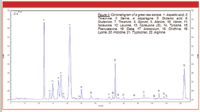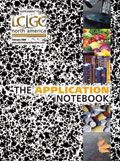Analysis of Theanine in Green Tea Using the Biochrom 30 Amino Acid Analyser
The Biochrom 30 Amino Acid Analyser is a well established analytical instrument for clinical diagnosis as its IVD approval allows the diagnosis of inborn errors of metabolism such as Phenylketonuria.
The Biochrom 30 Amino Acid Analyser is a well established analytical instrument for clinical diagnosis as its IVD approval allows the diagnosis of inborn errors of metabolism such as Phenylketonuria.

Figure 1: Chromatogram of a green tea sample. 1) Aspartic acid, 2)Threonine, 3) Serine, 4) Asparagine, 5) Glutamic acid, 6) Glutamine, 7) Theanine, 8) Glycine, 9) Alanine, 10) Valine, 11) Isoleucine, 12)Leucine, 13)Norleucine (IS), 14) Tyrosine, 15) Phenylalanine, 16) Gaba, 17) Ammonium, 18) Ornithine, 19) Lysine, 20)Histidine, 21) Tryptophan, 22) Arginine.
This robust and reliable instrument is also capable of other types of applications far from the clinical market e.g. its usage in the food industry allows routine analysis of amino acid content in food and feedstuff in quality control laboratories.
The Biochrom 30 can also be used for analysing rare, unusual amino acids or derived molecules for research purposes.
In order to develop new methods for analysing molecules of interest in the scientific market, a new application has been developed to analyse the theanine content in green tea leaves.
Theanine is a molecule derived from the amino acid glutamine and is usually found in tea (infusions of Camellia sinensis), and also in the basidiomycete mushroom Boletus badius. Because it can enter the brain, theanine has psychoactive properties. Theanine has been shown to reduce mental and physical stress, may produce feelings of relaxation, and improves cognition and mood when taken in combination with caffeine. These effects are believed to be caused by the ability of theanine to increase GABA production in the brain.
The chemical structure of theanine allows it to be separated and detected in green tea samples using a Biochrom 30 Amino Acid Analyser.
Experimental
A Biochrom 30 Lithium High Performance system was used for the analysis. It is equipped with a 20 cm × 4.6 mm I.D LiHP column and a set of Lithium Citrate buffers. The standard high performance elution program was used.
After the extraction of the free amino acid content from finely ground tea leaves in Lithium citrate buffer, the extracts were deproteinised with sulfosalicylic acid solution containing Norleucine as the internal standard. The samples were filtered through a 0.22 μm membrane. 40 μL was injected onto the column.
Results
Theanine elutes in 41 min and is clearly separated from any other amino acids presents in the tea. It also gives a high response when reacting with the Ninhydrin reagent. Furthermore, the method allows the identification of 20 other amino acids naturally present in tea in a single run.
The extraction method is simple and with the specific ion exchange chromatography method coupled with Ninhydrin detection, no matrix interference is detected with other types of molecules.
Once again, the Biochrom 30 reveals its flexibility, allowing the separation scientist to use it for various types of applications, without the inconvenience of heavy method development work.

Biochrom US
84 October Hill Road, Holliston, MA 01748
Email: tracy.everingham@biochrom-us.com
Website: www.biochrom-us.com

Automated Sample Preparation (ISO 20122) for MOSH/MOAH in Seasoning Oils
May 6th 2025This work presents an Automated Sample Preparation procedure for MOSH/MOAH analysis of Seasoning Oils. We compare results from a manual epoxidation procedure compliant with DIN 16995 with results based on fully automated sample preparation (epoxidation and saponification) compliant with ISO 20122. In both cases, online clean-up via activated aluminum oxide (AlOx) are used to remove interfering n-alkanes from the MOSH fraction during the HPLC run. Automated data evaluation using a dedicated software (GERSTEL ChroMOH) is presented.
Free Poster: NDSRI Risk Assessment and Trace-Level Analysis of N-Nitrosamines
April 25th 2025With increasing concern over genotoxic nitrosamine contaminants, regulatory bodies like the FDA and EMA have introduced strict guidelines following several high-profile drug recalls. This poster showcases a case study where LGC and Waters developed a UPLC/MS/MS method for quantifying trace levels of N-nitroso-sertraline in sertraline using Waters mass spectrometry and LGC reference standards.

.png&w=3840&q=75)

.png&w=3840&q=75)



.png&w=3840&q=75)



.png&w=3840&q=75)














